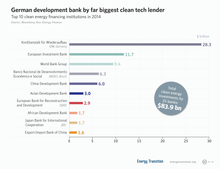Development finance institution

Development financial institution (DFI), also known as a Development bank, is a financial institution that provides risk capital for economic development projects on a non-commercial basis.
DFIs are often established and owned by governments or nonprofit organizations to finance projects that would otherwise not be able to get financing from commercial lenders.
They are often structured as a company that provides loans for projects that a government or nonprofit wants to encourage for non commercial reasons. They can be at a local, national or international level. DFIs include multilateral development banks, national development banks, bilateral development banks, microfinance institutions, community development financial institution and revolving loan funds.[1]
History
Development banks are a relatively new type of bank. Early developments included agricultural and land development banks such as the land development banks in India which were established in 1920s. One of the early international development banks was the French Development Agency which was established in December 1941 to finance projects in the French overseas provinces.
In December 1945, the World Bank came into being, this became the largest development bank. In February 1948, the Commonwealth Development Corporation (CDC) was founded in London.
Mandate
DFIs can play a crucial role in financing private and public sector investments in developing countries, in the form of higher risk loans, equity positions, and guarantees.[2]
DFIs often provide finance to the private sector for investments that promote development and to help companies to invest, especially in countries with various restrictions on the market.[2]
Some development banks include socially responsible investing, Environmental, social, and corporate governance (ESG) and impact investing criteria into their mandates. Governments often use development banks to form part of their development aid or economic development initiatives.
Climate financing
As of November 2020[update], development banks and private finance had not reached the $100 billion USD per year investment of climate financing stipulated in the UN climate negotiations for 2020.[3] However, in the face of the COVID-19 pandemic's economic downturn, 450 development banks pledged to fund a "Green recovery" in developing countries.[3]
Typology
Development banks include:
- Community development banks which fund low-income areas in the United States
- Land development banks which provide financing to develop agriculture in India
- National development banks are government-owned financial institution that provides financing for economic development.
- International financial institutions conducting development-oriented finance on a bilateral or multilateral basis
- Multilateral development bank are development banks set up by a group of countries and often operate under international laws.
See also
References
- ^ Andrea Levere, Bill Schweke, and Beadsie Woo, Development Finance and Regional Economic Development, Washington, DC: CFED, July 2006
- ^ a b Dirk Willem te Velde and Michael Warner (2007) Use of subsidies by Development Finance Institutions in the infrastructure sector Archived 2010-02-06 at the Wayback Machine Overseas Development Institute
- ^ a b "Banks around world in joint pledge on 'green recovery' after Covid". the Guardian. 2020-11-11. Retrieved 2020-11-12.
